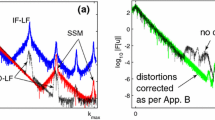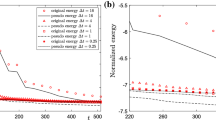Abstract
Geophysical flow simulations have evolved sophisticated implicit–explicit time stepping methods (based on fast-slow wave splittings) followed by time filters to control any unstable models that result. Time filters are modular and parallel. Their effect on stability of the overall process has been tested in numerous simulations. In this paper, we study the stability of the Crank–Nicolson-Leapfrog scheme with the Robert–Asselin–Williams time filter.


Similar content being viewed by others
Notes
Thus, we assume \(\nu \in (0,1]\) throughout the text.
For detailed proof, see the expanded version at http://www.mathematics.pitt.edu/sites/default/files/research-pdfs/CNLFraw.
References
Amezcua, J., Kalnay, E., Williams, P.D.: The effects of the RAW filter on the climatology and fore cast skill of the SPEEDY model. Mon. Weather Rev. 139(2), 608–619 (2010)
Asselin, R.: Frequency filter for time integrations. Mon. Weather Rev. 100(6), 487–490 (1972)
Dahlquist, G.: G-stability is equivalent to \(A\)-stability. BIT 18(4), 384–401 (1978)
Déqué, M., Cariolle, D.: Some destabilizing properties of the Asselin time filter. Mon. Weather Rev. 114(5), 880–884 (1986)
Durran, D.R.: Numerical methods for fluid dynamics: With applications to geophysics. In: Texts in Applied Mathematics, vol 32, 2nd edn. Springer, New York (2010)
Fornberg, B.: On the instability of leap-frog and Crank–Nicolson approximations of a nonlinear partial differential equation. Math. Comp. 2, 45–57 (1973)
Gresho, P., Sani, R., Engelman, M.: Incompressible Flow and the Finite Element Method. Advection–Diffusion and Isothermal Laminar Flow. Wiley, West Sussex (1998)
Hairer, E., Wanner, G.: Solving ordinary differential equations. II, Springer Series in Computational Mathematics, vol 14. Springer, Berlin (2010)
Haltiner, G., Williams, R.: Numerical Prediction and Dynamics Meteorology. Wiley, New York (1980)
Hundsdorfer, W., Verwer, J.: Numerical Solution of Time-dependent Advection–Diffusion–Reaction Equations. Springer Series in Computational Mathematics, vol. 33. Springer, Berlin (2003)
Jablonowski, C., Williamson, D.: The pros and cons of diffusion, filters and fixers in atmospheric general circulation models. In: Lauritzen, P.H., Jablonowski, C., Taylor, M.A., Nair, R.D. (eds) Numerical Techniques for Global Atmospheric Models, Lecture Notes in Computational Science and Engineering, vol 80, pp. 381–493. Springer (2011)
Johansson, O., Kreiss, H.O.: Über das Verfahren der zentralen Differenzen zur Lösung des Cauchy problems für partielle Differentialgleichungen. BIT 3, 97–107 (1963)
Kalnay, E.: Atmospheric Modeling, Data Assimilation and Predictability. Cambridge University Press, Cambridge (2002)
Layton, W., Trenchea, C.: Stability of two IMEX methods, CNLF and BDF2-AB2, for uncoupling systems of evolution equations. Appl. Numer. Math. 62(2), 112–120 (2012)
Li, Y., Trenchea, C.: A higher-order Robert–Asselin type time filter. J. Comput. Phys. 259, 23–32 (2014)
Lin, Y.L.: Mesoscale Dynamics. Cambridge University Press, Cambridge (2007)
Park, S., Xu, L.: Data Assimilation for Atmospheric, Oceanic and Hydrologic Applications. Springer, London (2009)
Robert, A.J.: The integration of a low order spectral form of the primitive meteorological equations. J. Meteorol. Soc. Jpn. 44, Ser. 2(5), 237–245 (1966)
Robert, A.J.: The integration of a spectral model of the atmosphere by the implicit method, pp. 19–24. In: Proceedings of WMO-IUGG Symp. on NWP. Japan Meteorological Agency (VII), Tokyo (1969)
Smith, R.J.: Minimizing time-stepping errors in numerical models of the atmosphere and ocean. Master’s thesis, University of Reading (2010)
Thomas, S.J., Loft, R.D.: The NCAR spectral element climate dynamical core: semi-implicit Eulerian formulation. J. Sci. Comput. 25(1–2), 307–322 (2005)
Verwer, J.: Convergence and Component Splitting for the Crank–Nicolson Leap-Frog Integration Method. Technical report, Centrum Wiskunde and Informatica (CWI) (2009)
Williams, P.D.: A proposed modification to the Robert–Asselin time filter. Mon. Weather Rev. 137, 2538–2546 (2009)
Williams, P.D.: The RAW filter: an improvement to the Robert–Asselin filter in semi-implicit integrations. Mon. Weather Rev. 139(6), 1996–2007 (2010)
Williams, P.D.: Achieving seventh-order amplitude accuracy in leapfrog integrations. Mon. Weather Rev. 141(9), 3037–3051 (2013)
Author information
Authors and Affiliations
Corresponding author
Additional information
Communicated by Mechthild Thalhammer.
Partially supported by the Air Force under grant FA9550-12-1-0191 and the NSF under grant DMS 1216465.
Rights and permissions
About this article
Cite this article
Hurl, N., Layton, W., Li, Y. et al. Stability analysis of the Crank–Nicolson-Leapfrog method with the Robert–Asselin–Williams time filter. Bit Numer Math 54, 1009–1021 (2014). https://doi.org/10.1007/s10543-014-0493-1
Received:
Accepted:
Published:
Issue Date:
DOI: https://doi.org/10.1007/s10543-014-0493-1




